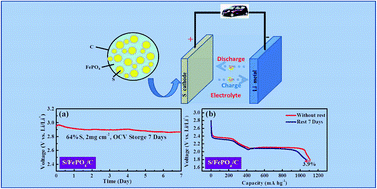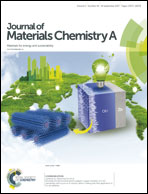A sulfur–FePO4–C nanocomposite cathode for stable and anti-self-discharge lithium–sulfur batteries†
Abstract
Lithium–sulfur batteries are regarded as promising candidates for energy storage devices owing to their high theoretical energy density. However, severe self-discharge due to the dissolution and shuttle effect of polysulfides hinders the practical application of Li–S batteries. In this work, we present a strategy to entrap sulfur in a mesoporous FePO4/carbon nanocomposite that relies on a chemical process, in which FePO4 bonds with sulfur to form S–O chemical bonds for high performance Li–S batteries. The prepared S/FePO4/C nanocomposite exhibits excellent cycling performance. It delivers an initial discharge capacity of 953.8 mA h g−1 and a discharge capacity of 550.8 mA h g−1 can be reserved after successive cycling for 500 cycles with a capacity decay rate of 0.05% per cycle at 0.5C. Also, the S/FePO4/C electrode exhibits extremely low self-discharge behavior. The cell voltage is stabilized at a high value of approximately 2.9 V after 7 days' rest with S/FePO4/C as the cathode. Even after 30 days' rest, the potential is still maintained at about 2.7 V, demonstrating an extremely low rate of self-discharge. In addition, both the areal capacity and the volumetric capacity of the S/FePO4/C electrode are superior to those of the S/carbon electrode, indicating its promising application in practical Li–S batteries.



 Please wait while we load your content...
Please wait while we load your content...